Saturday
Cooking Demonstrations
|
We thought we
felt a little morning chill the other day. That means autumn
is around the corner as is the resumption of our Saturday Cooking
Demonstrations! Join us each Saturday at 10:00 a.m. to gain
new knowledge from some of the area's cooking experts. No
reservation required. $5 per attendee.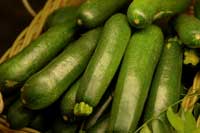
Saturday, Sep 8th - Time for Brunch -
Margaret Welder - These eye-opening ideas won't call for an early
wake-up. Margaret will share recipes for a Baked Caramel Apple
French Toast that can be made the night before and delicious
Pineapple Scones, using dried pineapple and cream
cheese.
Saturday, Sep 15th -
Zucchini -
Beatriz Spalding - A popular summer squash, fresh zucchini is
available year-round and can be cooked by a variety of methods
including steaming, grilling, sautéing, deep-frying
and baking.
Saturday, Sep
22nd - From Your
Garden - Robert Moore - Good-looking, good tasting,
and good for you! There is nothing quite like fresh fall
produce from the farmers' market or your garden for recipes that are
truly delicious, light, and a snap to prepare.
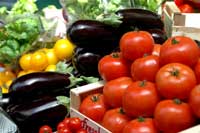 Saturday, Sep
29th - A Taste of Indian
Bread - Rama Sridhar - Nothing beats the warm,
aromatic, homemade taste of Indian breads! Today you will
enjoy full-flavored, handcrafted bread. Rama will show us how
to do the basic rotis and baranathas and variations as
well. Saturday, Sep
29th - A Taste of Indian
Bread - Rama Sridhar - Nothing beats the warm,
aromatic, homemade taste of Indian breads! Today you will
enjoy full-flavored, handcrafted bread. Rama will show us how
to do the basic rotis and baranathas and variations as
well.
Saturday, Oct 6th -
Autumn Dinner
Ideas - Karen Davis - Join Karen as she shares some of
her favorite autumn recipes. Orange-Glazed Pork Tenderloin is
wonderful roasted in the oven next to Savory Sweet Potato
Fries. Take home ideas suitable for casual dinners and easy
entertaining.
Saturday, Oct
13th - Warm Up with Fall
Soups - Margaret Welder - Two Welder family favorite
recipes will use the last of the garden produce -- Stuffed Pepper
Soup and Salsa Soup! Both are easy to make for a family
supper. While the soup simmers, Margaret will bake some simple
garlic buns using frozen bread dough.
Saturday, Oct 20th - Wickedly Wonderful Halloween
Fun - Andrea Moore - Halloween is full of
surprises! Andrea will dish out some special surprises and
treats for us to take advantage of for the holiday.
Saturday, Oct 27th - Cheese Blintzes and
Otherwise - Joe Geha - East meets East in an
Arab-Jewish potluck. Joe will demo blintzes (Jewish crepes)
made with the traditional blended cheeses and fruit fillings.
Others he'll fill with "Mirkatan" (the Arab touch), a dried fruit
and nut mixture macerated in jasmine tea and brandy, and finished
with a sprinkling of pomegranate seeds.
November 3, 2007 - Pie Revisited -
Margaret Welder - You'll have another chance to get Margaret's
piecrust recipe! She'll make an Apple Almond Cream Pie, which
has an almond-paste cream layer with the apples, and her Pumpkin Pie
which uses sweetened condensed milk.
November 10, 2007 - Smart Cookies! -
Andrea Moore - Baking cookies is the brightest idea of the holiday
season! It is a whole lot of fun (especially if there are kids
around) and they make an instant party (think tree trimming or
cookie exchanges). When they are all wrapped up they're a
great last minute gift! Andrea will get us all ready for the
most festive of seasons with some new
recipes! |
Salsa in the
Mainstream
|
|
 A long time fixture of
the appetizer table, salsa has danced its way into the main course
and even to the dessert plate. Salsa translates into English as
"sauce," but this generic description can't keep
step in salsa's world of colorful condiment
concoctions, each as unique as the cook contriving the dish.
While the classic foundation of salsa is tomatoes, onions, chilies
and spices, you may be pleased to find the characteristic salsa
flavors combined with fruits and even chocolate. Salsa, whatever
personality you give it, provides a low-fat, high flavor feature for
many eats. A long time fixture of
the appetizer table, salsa has danced its way into the main course
and even to the dessert plate. Salsa translates into English as
"sauce," but this generic description can't keep
step in salsa's world of colorful condiment
concoctions, each as unique as the cook contriving the dish.
While the classic foundation of salsa is tomatoes, onions, chilies
and spices, you may be pleased to find the characteristic salsa
flavors combined with fruits and even chocolate. Salsa, whatever
personality you give it, provides a low-fat, high flavor feature for
many eats.
Store shelves are
stocked with many well-known salsa brands. While some may criticize
their authenticity, it was this style of jarred salsas that piqued
the interest of consumers and increased demand.
In 1991, salsa surpassed ketchup as the most popular
condiment in the U.S.
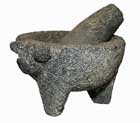 Don't worry if you just
finished off a "personal" bowl of salsa, this healthy blend of
ingredients is packed with fresh, full flavors, low calories, and
loaded with potassium and antioxidants. Round out
the nutrition with protein and fiber from some black
beans. So don't hold back!
Serve this low-fat flavor fusion with meats, potatoes, or try
a fruit salsa for dessert over yogurt, or low-fat ice cream. Don't worry if you just
finished off a "personal" bowl of salsa, this healthy blend of
ingredients is packed with fresh, full flavors, low calories, and
loaded with potassium and antioxidants. Round out
the nutrition with protein and fiber from some black
beans. So don't hold back!
Serve this low-fat flavor fusion with meats, potatoes, or try
a fruit salsa for dessert over yogurt, or low-fat ice cream.
Salsas were
traditionally made using a molcajete and
tejolote. A molcajete is a round
bowl with three legs made of basalt (volcanic rock).
Ingredients were added to the bowl and mashed using the
tejolote, (similar to a mortar and pestle).
These tools are still used today and many believe the mashing
process releases oils and flavor essences found only in the finest
salsas. Today, a more common, (and quick),
approach to salsa-making is the food processor.
This
appliance effectively chops and blends salsa ingredients into the
desired texture in seconds.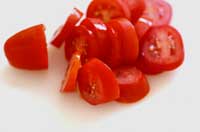
When making homemade
salsa, the type of tomato used will determine the thickness of the
sauce. Plum tomatoes, (Roma or Italian), produce
a nice thick salsa, while large slicing tomatoes create a juicier
consistency. Fresh salsa is only as good as its
ingredients; garden fresh tomatoes are obviously recommended.
Most salsas contain a
little "heat." With a wide array of chilies
available, salsa may play it cool with just a hint of sweetness, or
so HOT, tears will be streaming. The variety and
quantity of chile used in the recipe will determine the
"temperature." If you prefer, let your
taste buds idle and enjoy the mélange of flavors with a mild Anaheim
chile or jalapeño pepper. Or, if you enjoy
intense heat, jump into the blaze of the habañero or scotch
bonnet. When chopping a chile, the smaller the
size, the more evenly dispersed the heat sensation will be in the
mouth. 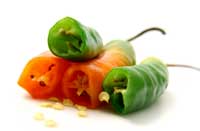
Mild Salsa - easy blend
of flavors; little to no heat.
Medium Salsa - taste buds awakened
by a little fire; but it's manageable
Hot Salsa - flames; dancing
all over the tongue
Fiery Hot - the fire bells are ringing; tears
are common. Only for the
courageous! |
"Salsa-bilities"
|
|
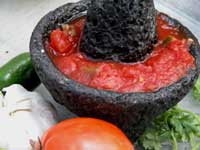 Salsa possibilities
range from the traditional to newer creations.
Traditional salsas are usually thought of as
tomato-based variations from Mexican or Southwestern cuisines.
But these cuisines also offer other salsas that are
familiar. Apply the heat, cilantro, and onion
from the traditional salsas, substitute some different fruits and
vegetables, and the possibilities are endless. Salsa possibilities
range from the traditional to newer creations.
Traditional salsas are usually thought of as
tomato-based variations from Mexican or Southwestern cuisines.
But these cuisines also offer other salsas that are
familiar. Apply the heat, cilantro, and onion
from the traditional salsas, substitute some different fruits and
vegetables, and the possibilities are endless.
Traditional
Salsas:
Improve your knowledge with this glossary of
salsas:
Salsa
roja -a "red sauce" that
includes cooked tomatoes, onion, garlic, chile peppers, and fresh
coriander. When pureed, it is sometimes used as an enchilada sauce.
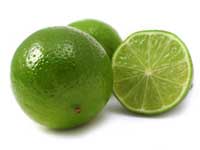 Salsa
cruda- a "raw salsa" also
known as pico de gallo (rooster's beak).
This popular salsa uses fresh ingredients like tomatoes,
cilantro, onions, lime juice, and chile peppers.
Whether homemade or purchased from a store this salsa lasts
up to 5 days in the refrigerator. Salsa
cruda- a "raw salsa" also
known as pico de gallo (rooster's beak).
This popular salsa uses fresh ingredients like tomatoes,
cilantro, onions, lime juice, and chile peppers.
Whether homemade or purchased from a store this salsa lasts
up to 5 days in the refrigerator.
Salsa
verde- a "green salsa" made
with tomatillos instead of tomatoes. It is milder than most red
salsas. Typical Mexican ingredients include tomatillos, chilies,
onions, garlic, and cilantro. There is an Italian
style which substitutes herbs for the tomatillos.
When made at home, these flavors blend best overnight.
Salsa
taquera- this "taco sauce"
combines tomatillos, morita peppers, onions, and spices.
As the name implies this blend of flavors is a nice addition
to tacos and burritos. Morita peppers are a
variety of small, red jalapenos that have been smoked, similar to a
chipotle pepper.
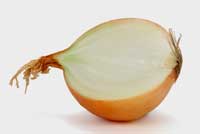 Salsa
ranchero- a "ranch sauce" most
commonly found in huevos rancheros (fried eggs served on a
tortilla and topped with salsa). It includes
tomatoes, onion, chilies, garlic, oil, and salt.
To create a more soup-like texture, the ranch style begins
with the light sautéing of ingredients in oil, and is typically
served warm. Salsa
ranchero- a "ranch sauce" most
commonly found in huevos rancheros (fried eggs served on a
tortilla and topped with salsa). It includes
tomatoes, onion, chilies, garlic, oil, and salt.
To create a more soup-like texture, the ranch style begins
with the light sautéing of ingredients in oil, and is typically
served warm.
Salsa
brava- translated as "wild
sauce," this spicy salsa is a blend of tomatoes, garlic, onions, and
spices cooked and reduced for an intense flavor impact. Salsa
brava is central to the well-known Spanish tapa called
patatas bravas (potatoes).
Other
Salsas: You may not think of the
following two when you hear the word salsa, but they too are
classified as salsas in Mexican and Spanish cuisines.
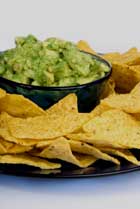 Guacamole - a classic sauce
dominated by avocadoes combined with the salsa cornerstones of
onion, chile, tomato, cilantro, and lime juice. Guacamole - a classic sauce
dominated by avocadoes combined with the salsa cornerstones of
onion, chile, tomato, cilantro, and lime juice.
Mole - This rich sauce
composed of various chili peppers, spices, seeds (like almonds or
sesame) incorporates unsweetened chocolate. The
ingredients are cooked together to create a sophisticated dark sauce
often served with chicken.
Fruit
Salsas:
A fresh addition to
grilled meats or fish, fruit salsas combine the essence of salsas -
onions, heat, and spice -- with the natural sweetness of
fruit. Change the tortilla chips to a
cinnamon-sugar variety, (see Tips below), and the fruit salsa
becomes a healthful, sweet treat.
Tropical
Blend - Combined in a coarse
chop, pineapple, kiwi, banana, and mango meld sweet and tart into an
equatorial flare.
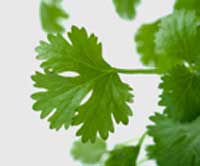 Citrus
Salsa - Orange segments
chopped with chipotle peppers in a bit of adobo sauce make for sweet
heat in the winter time. Citrus
Salsa - Orange segments
chopped with chipotle peppers in a bit of adobo sauce make for sweet
heat in the winter time.
Autumn
Salsa - Cranberries, apples,
and walnuts with the salsa basics of onion, chiles, and cilantro
make the most of late season harvests.
Apple
Salsa - Sweetened with a
little maple syrup or brown sugar, apples and green chile peppers
join their talents into a crunchy
collective. |
Food
Processors
|
|
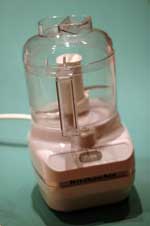 Salsa making is a cinch
with a food processor. Labeled as the fastest
growing small kitchen appliance by Consumer Reports, food processors
have gained popularity for their versatility and ease of use. Salsa making is a cinch
with a food processor. Labeled as the fastest
growing small kitchen appliance by Consumer Reports, food processors
have gained popularity for their versatility and ease of use.
First developed for the
catering business by a French salesman, the processor debuted in the
U.K. in the early 1960's. In the U.S., Carl
Sontheimer revolutionized kitchen prep work by modifying an
industrial blender creating the food processor for the
home. It was introduced as the Cuisinart in 1973.
This multi-talented, all-in-one appliance could chop, dice, blend,
puree, slice, shred, knead, whip, beat, juice, and julienne.
A good food processor
will quicken food preparation tasks with its ability to consistently
and efficiently produce uniform pieces of food.
While color choices and size options have changed in the
intervening years, the basic design has remained the
same. All food processors include a motor, bowl,
lid with feed tube, a small spatula, a chopping blade, (Sabatier
blade), and many optional attachments.
 Attachments build a
versatile machine: Attachments build a
versatile machine:
Sabatier
blade -
the standard blade that comes in the base configuration; good for
chopping and pureeing.
Shredding & slicing
discs -
great for cheeses and vegetables in a fine, medium or coarse grate,
or thin, thicker, or thickest slices.
Dough
blade -
slightly straighter than the Sabatier blade, it works well for small
batches of bread or pizza dough.
Egg whip - perfect for beating
cream, eggs and batter.
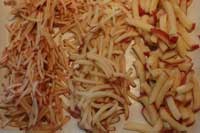 Julienne
disc -
creates uniform matchstick strips. Julienne
disc -
creates uniform matchstick strips.
French fry
disc -
similar to the julienne disc only on a larger scale.
Citrus
juicer
- juices oranges, grapefruits, lemons and limes.
Non-citrus
juicer
-juices vegetables and non-citrus fruits.
Extra
bowls -
interchange bowls for different prep needs without having to wash
between uses.
Storage
container - handy organizer for
efficient storage of attachments.
 Using a Food
Processor - A food processor is
very easy to use, typically with only three buttons, On, Off, and
Pulse. Rule One in using a food processor is to
respect its power - a few seconds in the "On" position will reduce
chunks to a puree. Avoid the misstep of overprocessed food by using
a gentle touch. Some foods are less forgiving than others like pie
crusts. When the dough is overprocessed, the fat
heats up, begins to melt, and turns flaky into crumbly in the final
result. The "Pulse" button allows greater control of the chop -
pulse once, twice or thrice, and you have a perfect salsa
consistency. Beyond the "Pulse" button, working
in stages is the secret of mastering the food processor. Salsa
provides a great forum for mastering staging techniques. Garlic and
chilies need to be pureed so they are processed first. Next the
onions and cilantro are added to be finely chopped. Tomatoes are
added last resulting in a chunky texture. Using a Food
Processor - A food processor is
very easy to use, typically with only three buttons, On, Off, and
Pulse. Rule One in using a food processor is to
respect its power - a few seconds in the "On" position will reduce
chunks to a puree. Avoid the misstep of overprocessed food by using
a gentle touch. Some foods are less forgiving than others like pie
crusts. When the dough is overprocessed, the fat
heats up, begins to melt, and turns flaky into crumbly in the final
result. The "Pulse" button allows greater control of the chop -
pulse once, twice or thrice, and you have a perfect salsa
consistency. Beyond the "Pulse" button, working
in stages is the secret of mastering the food processor. Salsa
provides a great forum for mastering staging techniques. Garlic and
chilies need to be pureed so they are processed first. Next the
onions and cilantro are added to be finely chopped. Tomatoes are
added last resulting in a chunky texture.
 Choosing a Food
Processor - Food processors are
found in three sizes for the home cook: (1) Full Capacity, 9-13
cups, (2) Compact, 5-7 cups, (3) Mini, 2-5 cup.
When shopping for a food processor, first determine how it
will be used. Basic tasks, such as, chopping and
pureeing can be done on any machine. If you're a
frequent entertainer, bake bread, or make pastas, then a larger
machine with a heavy duty motor is a must. On the
other hand, if it will primarily be used for chopping onions, making
small quantities of bread crumbs, or mixing pie crusts, then a
compact or mini would work well. Small quantities
of food don't process well in a large open volume bowl, so buy so
buy a size that fits your style. We offer the
best in KitchenAid® brand
food processors in different sizes: the 12-cup Ultra-Wide Mouth, the
7-cup, and the 3-cup Chef's Chopper. We'd be glad
to discuss the options for your food processor choice next time
you're in the shop! Choosing a Food
Processor - Food processors are
found in three sizes for the home cook: (1) Full Capacity, 9-13
cups, (2) Compact, 5-7 cups, (3) Mini, 2-5 cup.
When shopping for a food processor, first determine how it
will be used. Basic tasks, such as, chopping and
pureeing can be done on any machine. If you're a
frequent entertainer, bake bread, or make pastas, then a larger
machine with a heavy duty motor is a must. On the
other hand, if it will primarily be used for chopping onions, making
small quantities of bread crumbs, or mixing pie crusts, then a
compact or mini would work well. Small quantities
of food don't process well in a large open volume bowl, so buy so
buy a size that fits your style. We offer the
best in KitchenAid® brand
food processors in different sizes: the 12-cup Ultra-Wide Mouth, the
7-cup, and the 3-cup Chef's Chopper. We'd be glad
to discuss the options for your food processor choice next time
you're in the shop!
|
Plan Ahead
Tips
|
|
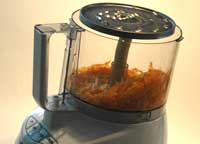 Tip #1:
Before shredding cheese
in the food processor, spray the disc with cooking spray for easy
clean up. Tip #1:
Before shredding cheese
in the food processor, spray the disc with cooking spray for easy
clean up.
Tip #2:
When emptying the food
processor work bowl, hold the bottom of the bowl in one hand placing
a fingertip in the hole contacting the collar of the
blade. Light pressure from the fingertip against
the collar's side will prevent the blade from falling into the
processed food.
 Tip #3: Homemade cinnamon and
sugar tortilla chips can be made by cutting flour tortillas into
triangles and placing them in a single layer on a baking
sheet. Spray with nonstick spray and sprinkle
with cinnamon and sugar. Spray with nonstick spray again to
set. Bake in a 350 degree oven until edges
are lightly browned and crispy, about 10-12 minutes. Substitute a
little salt for the cinnamon and sugar for a plain tortilla chip
variety. Tip #3: Homemade cinnamon and
sugar tortilla chips can be made by cutting flour tortillas into
triangles and placing them in a single layer on a baking
sheet. Spray with nonstick spray and sprinkle
with cinnamon and sugar. Spray with nonstick spray again to
set. Bake in a 350 degree oven until edges
are lightly browned and crispy, about 10-12 minutes. Substitute a
little salt for the cinnamon and sugar for a plain tortilla chip
variety.
|
Q & A
|
|

Q:
That salsa was way too
hot! How can I tame the flames?
A:
The burning sensation
common to chile peppers is caused by capsaicin.
Drinking or eating a dairy product (milk, cheese, or yogurt)
will quickly douse the fire. Eating bread and the
mere action of chewing will promote the production of saliva and
speed relief.
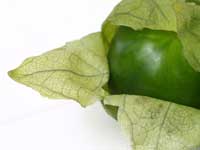 Q:
I have seen tomatillos
in the store. What are they, and how should they be
prepared? Q:
I have seen tomatillos
in the store. What are they, and how should they be
prepared?
A:
Tomatillos are small
green fruits with a paper thin husk. Sometimes
mistaken for green tomatoes, they are related, but not the
same. Tomatillos are typically used before they
ripen, when bright green, producing the desired tart
flavors. To use, remove the husk, wash and chop
or dice as needed.
Q:
What's the difference
between a food processor and a blender? Do I need
both?
A:
While the abilities of
food processors and blenders overlap, they excel in specific
ways. Food processors proficiently chop, slice,
shred, puree, and knead. Designed more for
liquids, a blender emulsifies, blends, and grinds well.
Each will earn their keep in the kitchen.
 Q:
I have so many tomatoes
in my garden, but no time to make salsa! Q:
I have so many tomatoes
in my garden, but no time to make salsa!
A:
If you don't have the
time to make and can large batches of salsa right now, the tomatoes
can be blanched, peeled, and frozen for later preparation. Visit
the National Center for Home Food
Preservation for recommendations on
canning salsas. It is important to use tested recipes designed for
home canning to ensure salsas have the right acid level for proper
preservation.
ess |
| Recipes |
|
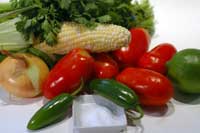 Fresh Tomato and Corn
Salsa Fresh Tomato and Corn
Salsa
Delicious with the
traditional corn tortilla chips, this salsa is also great on grilled
chicken or seafood. Makes about 1-1/2 cups.
1 small onion, peeled,
cut into 1-inch pieces
1/4 cup fresh cilantro leaves
1 medium
jalapeño pepper, seeded, cut into 1-inch pieces
2 medium
vine-ripened tomatoes, cut into 1-inch pieces
1 T. fresh lime
juice
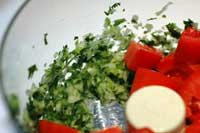 1/2 cup fresh or frozen
corn kernels (about 1 large cob) 1/2 cup fresh or frozen
corn kernels (about 1 large cob)
1/2 teaspoon kosher salt
(1) Place onion,
cilantro and jalapeño in the food processor's work bowl fitted with
the metal (Sabatier) blade.
(2) Process until finely chopped,
about 5 seconds. Scrape the sides of the work
bowl.
(3) Add tomatoes and line juice.
(4) Pulse until
tomatoes are coarsely chopped, about 5 to 7 times.
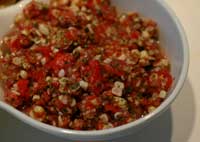 (5) Add corn and salt;
pulse once to just combine. (5) Add corn and salt;
pulse once to just combine.
(6)Let stand for 1 hour before
serving to allow the flavors to develop.
Variations:
Add black beans after processing for added nutrition.
All Cuisinart recipes are copyrighted works of
Cuisinart unless otherwise specified, used by Acorn Advisors with
permission from Cuisinart.
Fruit
Salsa
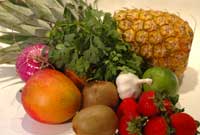 Though less common at
home, fruit salsas have been making a splash in many upscale
restaurants as an exquisite, fresh topping for seafood and meats.
Colorful, flavorful, low-calorie - it's hard to beat! Though less common at
home, fruit salsas have been making a splash in many upscale
restaurants as an exquisite, fresh topping for seafood and meats.
Colorful, flavorful, low-calorie - it's hard to beat!
1/2 small sweet onion,
cut into 1-inch chunks
1 clove of garlic, cut
1 jalapeño
pepper
1/4 cup cilantro leaves
Zest of 1 lime
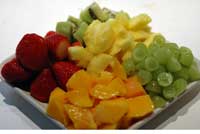 Juice of 1 lime (about 2
T.) Juice of 1 lime (about 2
T.)
7 large strawberries, halved
1 cup fresh pineapple in
chunks
2 kiwi, cut into 1-inch chunks
1 mango, cubed into
1-inch chunks
1 peach, peeled, cut into 1-inch chunks
(1) Place the onion,
garlic, jalapeño pepper, and cilantro in the food processor's work
bowl fitted with the metal (Sabatier) blade.
 (2) Process until finely
chopped, about 5 seconds. Scrape the sides of the
work bowl. (2) Process until finely
chopped, about 5 seconds. Scrape the sides of the
work bowl.
(3) Add the lime zest and juice.
Pulse once or twice to combine.
(4) Add the
strawberries, pineapple, kiwi, mango and peach.
Pulse sparingly to chop the fruit to a very chunky
consistency. Scrape the sides of the work bowl in
between pulses as needed.
(5) Allow the finished
fruit salsa to stand for 1 hour before serving to allow the flavors
to
develop. | |